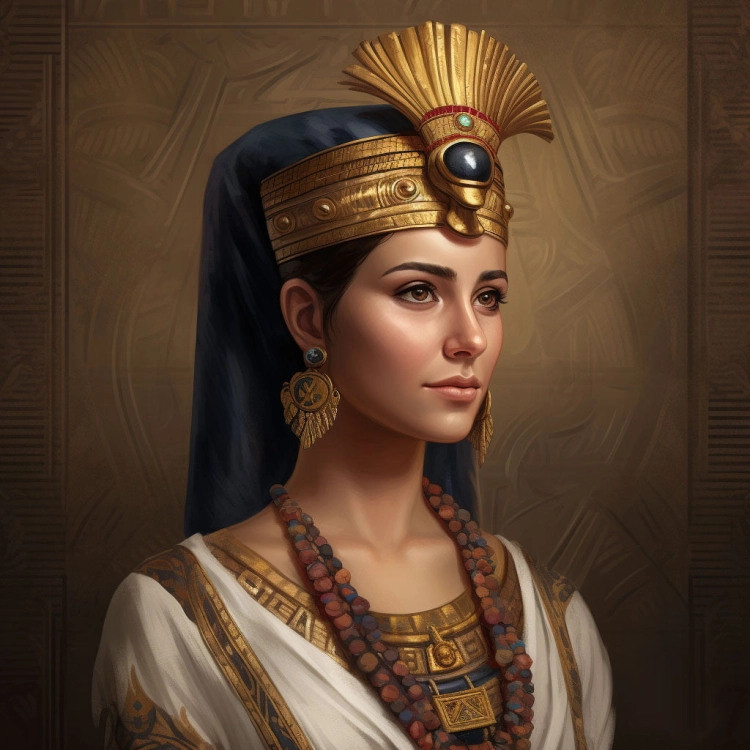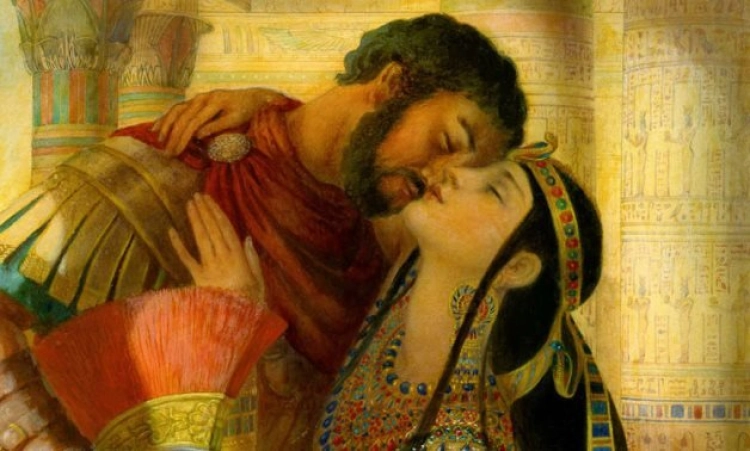

Cleopatra VII Philopator (69-30 BC) wasn’t just the last queen of the Ptolemaic Kingdom of Egypt; she was a ruler whose intelligence, charisma, and involvement in political turmoil left a lasting imprint on world history. Known for her sharp political mind and undeniable charm, Cleopatra navigated a world of power struggles and personal drama with remarkable flair. This story takes you through the fascinating journey of Cleopatra’s life, her rise to power, and the tragic end that secured her place as one of the most iconic figures of the ancient world.

Cleopatra VII was born in 69 BC into a royal family that had ruled Egypt for nearly three centuries. This dynasty, known as the Ptolemaic dynasty, was of Macedonian Greek origin, established after the death of Alexander the Great by Ptolemy I Soter, one of his trusted generals. Her father, Ptolemy XII Auletes, ruled Egypt during a time of great political and economic uncertainty. While the identity of Cleopatra's mother remains unclear, she is widely believed to be Cleopatra V Tryphaena.
Cleopatra was not an only child but part of a large and tumultuous family. She had two older sisters, Cleopatra VI and Berenice IV, along with a younger sister, Arsinoe IV, and two younger brothers, Ptolemy XIII and Ptolemy XIV. These siblings, however, were not just family; many would later become her rivals in a ruthless quest for power.
From a young age, Cleopatra stood apart from her predecessors. While most Ptolemaic rulers only spoke Greek, she was reported to have spoken up to nine languages, a testament to her exceptional education. Raised in Alexandria, one of the world’s great intellectual centers, Cleopatra had access to the famed Great Library of Alexandria, where scholars and thinkers gathered from across the ancient world.
Her education would have covered a broad range of subjects—mathematics, philosophy, oratory, and astronomy. But more importantly, she was also trained in politics and leadership, preparing her for the throne. Unlike the rulers before her, Cleopatra embraced Egyptian culture, learning the language and customs of her subjects, and presenting herself as the reincarnation of the goddess Isis. This cultural connection, along with her intellect, helped her win the loyalty of the Egyptian people.
Did You Know? Cleopatra was the first Ptolemaic ruler to speak Egyptian. While her Greek ancestors ruled Egypt for centuries, none had taken the time to learn the local language. This unique quality, along with her fluency in other languages, allowed Cleopatra to communicate directly with her subjects, enhancing her effectiveness as a ruler and solidifying her place as one of Egypt’s most beloved pharaohs.
At just 18 years old, Cleopatra ascended to the throne alongside her 10-year-old brother, Ptolemy XIII, following their father’s death in 51 BC. In typical Ptolemaic fashion, the siblings were also married to each other to legitimize their joint rule—a common practice among the dynasty to maintain power within the family. However, the early years of Cleopatra’s reign were anything but smooth.
Ptolemy XII, their father, had left Egypt in a fragile state, burdened by an economic crisis fueled by his extravagant lifestyle and the heavy costs of maintaining Rome’s favor. Despite inheriting this chaotic situation, Cleopatra quickly proved her resilience and political savvy. She took bold steps to stabilize Egypt’s economy and assert herself as the dominant ruler. Unlike her predecessors, she fully embraced the customs and language of her people, becoming the first Ptolemaic ruler to speak Egyptian. This cultural shift endeared her to her subjects, earning her both their respect and loyalty.

Cleopatra’s early reign was far from peaceful. Tensions quickly arose between her and her younger brother, Ptolemy XIII, with whom she co-ruled. Their relationship grew increasingly hostile, not helped by Ptolemy’s advisors—most notably the scheming eunuch Pothinus and the ambitious general Achillas—who sought to sideline Cleopatra and consolidate power for themselves. The royal court became a battleground, and soon, this internal conflict erupted into a full-blown civil war.
By 48 BC, Cleopatra had been forced to flee Alexandria, driven out by her brother’s forces. She retreated to Egypt’s eastern frontier, but this period of exile would prove to be a critical turning point. Refusing to accept defeat, Cleopatra sought out an ally who could help her regain her throne—none other than Julius Caesar, the most powerful man in Rome. This bold move would not only alter her fate but also the course of Egypt’s history.
Her early years as ruler, defined by political turmoil and civil war, forged her into a resilient and shrewd leader. Faced with adversity, Cleopatra responded with strategy and determination, traits that would carry her throughout her reign. Her successful navigation of these early challenges paved the way for her eventual return to power, solidifying her place in history as one of Egypt’s most influential and enduring pharaohs.
In 48 BC, Cleopatra’s quest to reclaim her throne led her to Julius Caesar, one of the most powerful figures in Roman politics. Caesar had come to Egypt chasing his rival, Pompey, only to discover that Pompey had been murdered by orders of Cleopatra’s brother, Ptolemy XIII, in a misguided attempt to win Caesar’s favor. Far from pleased, Caesar was disgusted by the act and saw an opportunity to intervene in the dispute between Cleopatra and her brother. It also offered him a chance to secure control over Egypt’s vast resources.
Legend has it that Cleopatra, in a bold and clever move, had herself smuggled into Caesar’s palace rolled inside a carpet. When the carpet was unfurled, she made a dramatic entrance, captivating the Roman general with her intelligence and charm. This marked the beginning of a partnership that was driven by both political survival and romance.
Aligning with Caesar was a masterstroke for Cleopatra. As leader of the Roman Republic, Caesar wielded immense military power, which she desperately needed to reclaim her throne. For Caesar, the alliance with Cleopatra provided access to Egypt’s wealth and strategic location, making it a mutually beneficial relationship.
Their partnership soon evolved into a romantic affair, and in 47 BC, Cleopatra gave birth to a son, Caesarion, or "Little Caesar." Though Caesar never formally acknowledged Caesarion as his heir, Cleopatra consistently presented him as Caesar’s son.
With Caesar’s military backing, Cleopatra waged a successful campaign to regain her throne. The conflict culminated in the Battle of the Nile, during which Ptolemy XIII drowned while trying to flee. After this victory, Cleopatra was restored as Egypt’s ruler, now alongside her younger brother, Ptolemy XIV.
Cleopatra visited Rome at least twice during her relationship with Caesar, living in his villa just outside the city. Their open affair—and the presence of their son—was a scandal in Rome, especially as Caesar was already married to Calpurnia. Nevertheless, their political and personal alliance greatly influenced the future of both Egypt and Rome.
Their relationship came to an abrupt end in 44 BC when Caesar was assassinated in Rome. With the political climate becoming too dangerous, Cleopatra fled back to Egypt. Despite the sudden end of their romance, her alliance with Caesar left a lasting impact on both empires, marking a pivotal moment in their intertwined histories.

Following Julius Caesar’s assassination in 44 BC, Rome’s political landscape was thrown into chaos. Power was divided among three influential men: Mark Antony, Marcus Aemilius Lepidus, and Caesar’s adopted heir, Gaius Octavius Thurinus (later known as Augustus). This triumvirate ruled Rome, with each man vying to expand his influence and power.
In 41 BC, Mark Antony sought out Cleopatra. His goal was twofold: to gauge her loyalty in the ongoing conflict with Caesar’s assassins and to secure financial and military support for his planned war against the Parthian Empire. Cleopatra, ever the strategist, saw an opportunity in Antony—one that could strengthen her position and ensure the security of Egypt.
Their initial meeting sparked a passionate relationship that was as politically advantageous as it was personal. In 40 BC, Cleopatra gave birth to twins, Alexander Helios and Cleopatra Selene II, further cementing their alliance. Antony spent the winter of 40-39 BC in Alexandria, a period remembered as “The Alexandrian Winter,” during which the two indulged in lavish festivities and even formed an exclusive drinking club called the "Inimitable Livers."
Several years later, in 37 BC, Antony returned to Egypt after a prolonged conflict with the Parthians, and Cleopatra bore him a third child, Ptolemy Philadelphus. Antony’s deepening ties with Cleopatra became more public when he officially granted royal titles to their children—a political move that infuriated many in Rome. Octavian, in particular, seized upon Antony’s actions, portraying him as a man under the spell of Egypt’s queen, a narrative that would fuel Roman resentment.
Antony’s decision to divorce his Roman wife, Octavia—who happened to be Octavian’s sister—only further escalated tensions. In 34 BC, Antony held a grand parade in Alexandria, known as the “Donations of Alexandria,” where he distributed vast territories to Cleopatra and their children. This spectacle was seen as a blatant insult to Rome, reinforcing Octavian’s position against Antony and Cleopatra.
The growing animosity between Octavian and Antony finally came to a head in 31 BC at the Battle of Actium. The combined naval forces of Antony and Cleopatra were decisively defeated by Octavian’s general, Agrippa. Antony and Cleopatra fled back to Egypt as Octavian’s forces pursued them relentlessly.
By 30 BC, with Octavian closing in, Antony received false news of Cleopatra’s death. In despair, he fell on his sword, fatally wounding himself. Cleopatra, overcome with grief and aware that her reign was at an end, made the fateful decision to take her own life. According to legend, she allowed an asp, a venomous Egyptian cobra, to bite her, choosing death on her own terms.
The partnership between Antony and Cleopatra was defined by political maneuvering and ambition. Their alliance significantly influenced the Mediterranean world, but their defeat marked the end of the Hellenistic era and cleared the path for Roman control.
As the last pharaoh of Egypt and one of the most renowned female rulers in history, Cleopatra's influence continues to resonate over two millennia after her death. Despite her non-Egyptian heritage, she is remembered as a pivotal figure in Egyptian history, guiding her kingdom through a period of immense political turmoil and uncertainty. Cleopatra worked to stabilize Egypt’s economy, undertook significant infrastructure projects, and, through her command of multiple languages, communicated directly with her subjects—strengthening her position as a ruler.
Her strategic alliances with two of Rome’s most powerful men, Julius Caesar and Mark Antony, played a crucial role in her efforts to maintain Egypt’s independence. These relationships, while often sensationalized in art and literature, were as much about politics as personal connection, greatly impacting the political landscape of the Roman Empire.
Over the centuries, Cleopatra's life has inspired countless adaptations, from ancient Roman propaganda to Shakespearean plays and modern films. Though often portrayed as a symbol of beauty and seduction, it was her intelligence, political skill, and determination that truly defined her reign. Despite the many interpretations—often influenced by cultural biases—Cleopatra remains a subject of fascination.
Her death marked the close of the Hellenistic era and the rise of Roman control over Egypt. Roman emperors, captivated by Egyptian culture, incorporated its art, architecture, and symbols into their own, sparking the "Egyptomania" that continues to this day.
In modern times, Cleopatra is often viewed as a feminist icon, a woman who asserted her authority in a male-dominated world and made decisions that shaped the future of her kingdom. Her story continues to spark discussions about women's roles in politics and leadership.
Cleopatra’s impact is undeniable. As a ruler and political strategist, she stands as a symbol of female power and historical significance. Even today, her story captivates and inspires, reflecting the complexity of her character and the lasting importance of her reign.

The question of Cleopatra’s skin color has sparked renewed debate, particularly after a recent Netflix documentary portrayed her as a black African woman. This has reignited long-standing discussions about her appearance.
However, the exact details of Cleopatra’s physical appearance, including her skin color, remain unknown. No contemporary portraits or descriptions survive. What we do know comes from ancient coins, statues, and busts, which provide stylized representations rather than accurate likenesses.

Cleopatra was of Macedonian Greek descent, a descendant of Ptolemy I, one of Alexander the Great’s generals, who established the Ptolemaic dynasty in Egypt. The Ptolemies were part of the Hellenistic world, which dominated the Eastern Mediterranean after Alexander’s conquests. As the dynasty often practiced inbreeding to preserve the royal bloodline, it's likely that Cleopatra’s physical traits were consistent with her Macedonian Greek heritage.
That said, Cleopatra’s Egyptian birthplace and the centuries her family ruled there leave open the possibility of some local or regional ancestry. Without concrete evidence, her skin tone could have ranged from lighter Mediterranean to darker North African shades. However, no historical documentation supports this theory definitively.
While Cleopatra’s skin color remains a mystery, her significance lies in her political achievements, strategic alliances, and her role as a powerful leader in a time of great change—not in her physical appearance.